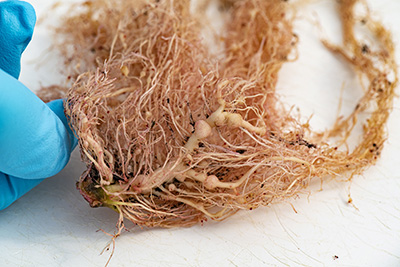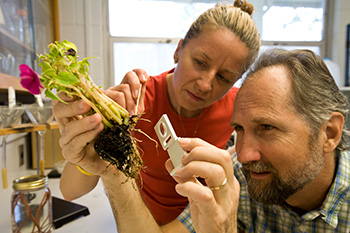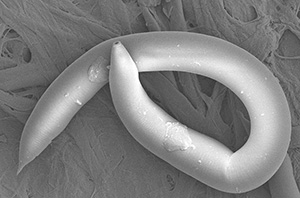The Invisible Nuisance: Nematodes for Beginners
Managing the health of plants can be a challenging process, especially when the culprit to the plant’s demise is not inherently visible.

There are many life forms residing in your yard—some are welcome residents while others remain less desirable. The nematode is one creature that lurks within the soil in a variety of landscapes, including home gardens and lawns.
Nematodes are tiny roundworms, so small they cannot be seen with the naked eye. Most nematodes are beneficial to plants because they feed on bacteria, fungi, and other microscopic organisms, but some feed directly on live plants. These plant-parasitic nematodes can damage a plant’s root system, hindering its ability to gain nutrients and water from the soil.
Signs of nematode damage
Nematode damage to bedding plants or vegetable gardens resembles drought stress, such as stunted growth and yellowing, thinning, and wilting of the foliage. Damage usually originates in a localized area of the garden and then spreads to a wider area over time. With trees and shrubs, damage from nematodes gradually presents itself over a long period of time, from months to years. Trees and shrubs will usually thin out and shed leaves when afflicted with nematodes rather than die a sudden death. But if a plant dies with leaves still intact, it’s likely caused by something other than nematodes.
Turfgrass that has damage from nematodes will usually exhibit short, stubby dark roots that appear rotted. If nematode populations become high enough, turfgrass might become yellow or brown and wilted, allowing weeds to move in as the grass thins out. Plants added to an area with a high count of parasitic nematodes may become stunted and die slowly over time. Transplants may not even grow at all if the infestation is bad enough. These parasites are also capable of damaging underground edible parts of plants such as carrots or potatoes.
Determining if nematodes are the problem
Most plant-parasitic nematodes can only be seen with a microscope. Hence, to know for sure if nematodes plague your garden, the soil and roots of the affected plants must be tested by a nematode-diagnostic lab. Symptoms of nematodes feeding on plants can be similar to other conditions like fungus, disease, or insects, so a definitive test can help you make decisions on how to treat the affected area.

The University of Florida Nematode Assay Lab and some private labs can test for nematodes. For further instruction on submitting samples to the UF Nematode Assay Lab, visit these Ask IFAS documents:
Types of nematodes
One of the most vicious plant parasites and the most well-known of the plant-parasitic nematodes is the root-knot nematode. By injecting a hormone into the roots of plants, these nematodes cause knots or galls to form. They initiate multiple physiological changes to the plants that make them more susceptible to fungal and bacterial plant disease like root rot. Vegetable and ornamental plants can die at the hands of this plant parasite when high infestations occur. Vegetables that are particularly susceptible to root-knot damage include tomatoes, potatoes, okra, beans, peppers, eggplants, peas, cucumbers, carrots, field peas, squash, and melons.
Other nematodes that cause damage to vegetable and bedding plants include sting, awl, and stubby-root nematodes, all of which cause roots to be stunted. By destroying the plant’s root system, these nematodes can ultimately kill plants. The stubby-root nematode commonly wreaks havoc on turfgrass. For a list of other nematodes that infect specific types of turfgrass, read Nematode Management for Residential Lawns from Ask IFAS.
Ornamental plants, vegetables, and tropical fruits can be damaged by reniform nematodes. Cyst nematodes are occasionally the culprit for damage to cruciferous vegetables (greens, broccoli, cabbage, etc.). Lesion and lance nematodes make the plants susceptible to root-rot and vascular wilt disease. Citrus and burrowing nematodes commonly afflict citrus plants by causing various diseases. Some plant-parasitic nematodes feed on the leaves and stems of plants, including pine wilt nematode (infecting pine trees) and foliar nematodes (infecting plant tissue of leaves and buds).
Methods of managing nematodes
To best manage nematode infestation for turfgrass, you should prevent other stressors from making the lawn more susceptible; a healthy lawn is the best defense. Compost, mulch, and manure have been shown to help improve plant resistance to plant-parasitic nematodes by allowing the soil to hold more water and nutrients. It’s also important to inspect the roots of sod transplants to ensure they are not already infected.
You can also cover any nematode-infected soil with a clear plastic tarp during the summer—a method called soil solarization—for at least 6 weeks to reduce fungi and nematode problems. Choosing plants resistant to or tolerant of nematodes can help avoid problems with certain species. Nematode-resistant cover crops can be used in vegetable gardens to decrease the number of harmful nematodes in the soil over time. Rotating your crops in the vegetable garden will help prevent the build-up of nematodes in the soil. In general, older, mature transplants are more resistant to nematodes so will do better in soil infested with nematodes compared to younger transplants. Some biopesticides can also be effective on certain nematodes.

Nematodes thrive more in warmer temperatures, so annual plants grown in cooler months often see less nematode damage. To take advantage of the cooler growing seasons, plant annuals as early as possible in the spring and allow them to grow as late as possible in the fall, taking into account the plant’s temperature requirements.
Plant-parasitic nematodes lurking in the soil can cause significant damage to plants in your yard or garden; however, taking certain preventative measures or testing your soil can help lessen the effects of these nuisance worms. Before taking any corrective action like soil solarization, take a targeted approach and avoid unnecessary treatments by making sure you have a clear understanding of what’s causing the problem.
